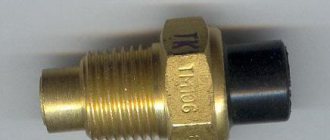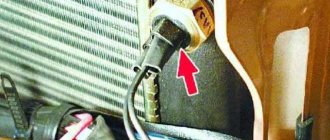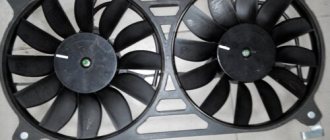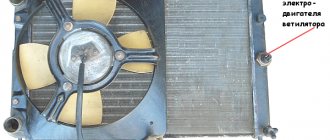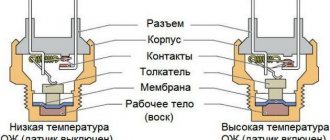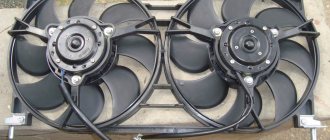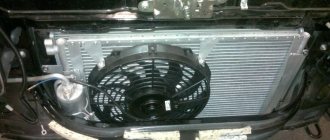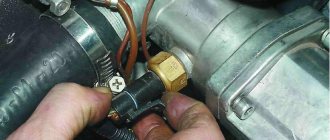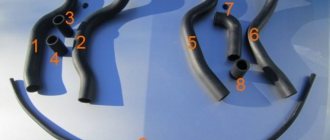Most owners of VAZ-2107 cars have encountered the problem of engine overheating due to untimely activation of the radiator fan. Such a malfunction poses a serious threat not only to the cooling system, but also to the entire power unit. An increase in coolant temperature to critical levels can damage the cylinder head gaskets, valve cover, and also cause jamming of the moving parts of the engine.
Most often, the radiator fan does not work due to problems with its activation sensor. This can be either a banal lack of contact on the connectors or failure of the device as a whole. In this article we will talk about what measures can be taken if the fan switch on the VAZ-2107 has lost its functionality, and we will also consider the process of checking and replacing it.
Signs of engine overheating and precautions
If you, while driving a car, find that the arrow on the instrument indicating the coolant temperature has moved into the red sector and continues to deviate in the direction of increasing it, it would be better to stop on the side of the road and immediately turn off the engine. If this is not done, the antifreeze or antifreeze will simply boil and try to escape, breaking the tightness of the system. Continuing to drive in such a situation is quite dangerous. Having stopped, it is necessary to check the functionality of all elements of the cooling system and determine the cause of overheating. Then, if possible, it should be eliminated. And if this is not possible, tow the car to the nearest service station.
Controller diagnostics
To diagnose the controller, you will need a calibrated thermometer that can operate at the boiling point of water. The diagnostic procedure is carried out as follows:
- Often the sensor facing the inside of the radiator should be placed in water.
- Next, the tester probes are connected to the controller contacts, and they are adjusted to ensure there is no resistance.
- When the liquid begins to heat up, the resistance disappears at approximately 87-92 degrees. If so, then the controller is healthy and will work as expected.
What's wrong with the fan?
If you suspect a faulty radiator fan is overheating, first check that it is working. This is not difficult to do. Disconnect the electrical connector from the electric motor, and supply electricity from the battery to its contacts. Do not mix up the polarity!
If the fan does not work when connected directly, the reason must be sought in the electric drive. If the electric motor starts working, the problem most likely lies in the elements that ensure its activation. This could be a fuse, relay, wiring, or sensor.
For carburetor systems
There are still many VAZ 2107 cars in use on the roads with a carburetor supply of the fuel mixture. As in the injector, engine cooling occurs thanks to the radiator and fan, only the process is regulated by a fan sensor.
Location and principle of operation
On older cars, additional cooling begins when the antifreeze reaches a certain temperature, usually 92 °C (there are differences for individual sensors). Carburetor systems are equipped with 2 coolant sensors - one to regulate fan operation, and the second sends readings to the driver’s instrument panel.
The sensor that turns on the fan is located on the bottom of the radiator panel, on the right side. To see it, you need to lift the hood and on the back you can see a “nut” with wiring. Usually these are modifications of the TM-108.
Further check
Further testing should be carried out according to the scheme “from simple to complex”. Diagnosing wiring without the appropriate tools and skills is almost impossible. The situation is similar with relays. It is unlikely that you will be able to check it yourself, especially in the field. The only thing you can do is pull out a similar device from a nearby socket or another car and insert it into the corresponding socket. It works - the reason is established, the fan does not work - we move on.
There will be no problems checking the fuse. We find the required insert in the mounting block, check it with a regular tester or a homemade probe made of two wires and a lamp, and the result is obvious. If necessary, change the fuse and continue driving. But if this time we were wrong, the problem should be looked for in the fan switch sensor.
Designs and principles of operation of sensors
Over the years, various models of fan switching sensors were installed on VAZ 2107 cars. At first these were electromechanical sensors, then they were replaced by electronics. Let's take a closer look at each device.
Electromechanical sensor VAZ 2107
Inside the electromechanical sensor there is a small container with ceresite mixed with copper powder. Above this substance there is a flexible membrane with a pusher attached to it. And the pusher, in turn, is connected to the moving contact. This entire structure is housed in a steel case with thick walls (which are necessary to ensure more uniform heating of the sensor). On the outside of the housing there are threads and a pair of electrical contacts.
The sensor operates on a simple principle: the volume of ceresite changes with increasing temperature. Ceresite, heating up under the influence of almost boiling antifreeze, expands and raises the membrane, which sets the pusher in motion. It reaches the moving contact and closes it, which causes the fan to turn on. When the temperature of the antifreeze drops due to additional airflow, the ceresite cools down, the membrane goes down, the contact opens and the fan turns off.
Where is the fan switch located?
For all outdated modifications of the “classic”, the sensor is located on the cooling radiator housing. Bottom right to be precise. From the outside, it looks like a brass nut “30” with two contacts out. Lift the hood, look at the back of the radiator - you will definitely see it. The principle of operation of the sensor is very simple. The thermocouple reacts to an increase in temperature, closes the contact, and voltage is supplied to the fan. For vehicles with controlled fuel injection, the fan is turned on by a command from the electronic unit based on data received from the sensor. In other words, the ECU itself controls all processes. But where is the fan switching sensor located on injection-powered “sevens”?
As already mentioned, they do not have such a device at all. Don't look for it on the radiator or anywhere else! But pay attention to the thermostat. A coolant temperature sensor is installed on its body. It then transmits to the electronic control unit all the necessary information about the coolant temperature.
Troubleshooting algorithm
If the electric cooling fan does not work on your VAZ 2107 (carburetor), you need to do the following:
- Turn off the engine and turn on the ignition.
- Use a flat-head screwdriver to short-circuit the terminals of the fan switch sensor. Please note that all control is based on mass. If the fan turns on, the sensor is faulty. If it doesn’t work, then the reason lies deeper.
- Disconnect the block from the electric fan and supply power from the battery directly. A rotating rotor indicates that the engine is running. If the electric fan does not work even this way, you will have to think about replacing it.
- If the fan and sensor are working properly, you need to check the electromagnetic relay (if present in the circuit).
- The wires are checked last. Oxidation very often occurs at the joints with the car body. And sometimes a banal break even happens.
The same algorithm can partly be applied to cars on which an injector is installed.
But in order to compare and appreciate the difference, it is worth considering such machines.
Sensor check
Now let's talk about how to check the fan switch sensor (VAZ-2107). Let's start with the carburetor engine. Everything is very simple here. All you need to do is disconnect the wires from the sensor. To do this, remove the electrical connector from its terminals. To determine whether the device is working properly, turn on the ignition and close the contacts on the connector. If it's all about the sensor, the fan will definitely turn on.
It may also happen that the fan switching device does not respond correctly to temperature. In other words, the contact closure mechanism works, but at a higher value. So, for carburetor VAZ-2107 cars, the fan switch sensor should close the circuit when the coolant reaches a temperature of 92 degrees, and open it at 87 ºС.
For engines with variable fuel injection, the inspection process is slightly different. Since VAZ-2107 injection cars do not have a fan switch sensor, you need to check the temperature controller. But first you should check the presence of voltage at the connector contacts. Take the tester and turn it on in voltmeter mode. Connect the negative wire of the device to ground, and connect the positive wire to contact “A” on the connector. Turn on the ignition. The tester must show a voltage of at least 12V. If its value is reduced, the problem must be looked for in the control unit. But if the voltage is okay, unscrew the temperature controller from the pipe for further checking.
Testing the sensor involves measuring its electrical resistance at different temperatures. Switch the tester to ohmmeter mode and measure the resistance at its contacts. It is noteworthy that it rises and falls in inverse proportion to the coolant temperature (20 ºС – 3.5 kOhm; 40 ºС – 1.5 kOhm; 80 ºС – 340 Ohm; 90 ºС – 250 Ohm). While measuring resistance, the controller can be heated by placing it in a container of hot water. The temperature of the fan switching sensor (VAZ-2107, injector) for different versions of ECU firmware can be 92-95 ºС. Its resistance is close to zero.
It should be noted that the fan activation and coolant temperature sensors cannot be repaired. Therefore, if the slightest malfunction is detected, they must be replaced. Let's consider the replacement process for each engine separately.
For injection system
Forced fuel supply in the "seven" for the Russian market began to be used in 2006. In these car models, the fan operation and other functions are performed by the ECU. On the VAZ 2107 injector, the signal about the antifreeze temperature comes from the coolant temperature sensor, which is located on the right side of the engine cylinder block.
The data is processed by the ECU, which outputs a signal to the control relay to turn on the cooling - circuit diagram. The fan switching sensor is not needed on VAZ 2107 injection systems; it is replaced by a thermistor sensor, and control functions are assigned to the controller.
In any “seven”, to protect the fan from short circuit, there is a fuse F7 located in the mounting block.
Operation of the coolant temperature sensor for the injection system
Usually, turning on the fan on a VAZ 2107 is accompanied by a noise that the driver hears while sitting behind the wheel. A prolonged absence of sound from the device when driving around the city in the summer may indicate a malfunction in the cooling system, which can lead to antifreeze boiling and damage to engine components. The driver must react quickly to such defects so as not to spoil the “heart” of his car.
One of the possible malfunctions in the engine cooling cycle may be a breakdown of the coolant temperature sensor. In addition to the cooling system, it is responsible for the correct supply of the air-fuel mixture to the engine and its inclusion in idle mode.
The sensor that affects the operation of the VAZ 2107 injector fan consists of a semiconductor thermistor with two terminals, soldered into a housing with a thread that is screwed into the wall of the cylinder block. A constant voltage of 5 V is supplied to the device. As the temperature of the antifreeze increases, the resistance of the thermistor decreases and vice versa. At the input to the computer, passing through a resistor, the voltage drops as the coolant temperature increases to a certain level, after which the controller gives a signal to turn on the cooling.
How to check and install a new one
Checking the sensor responsible for turning on the fan does not require much effort. The following signs may serve as grounds for verification:
- The “Check Engine” light on the instrument panel is on.
- The fan operates continuously or is turned off.
- Low idle torque.
- Coolant overheating.
The cause of the malfunction may be outdated wiring. To find out for sure, you need to check it, and then move on to the sensor.
- The negative cable of the battery is disconnected.
- On a cold engine, the antifreeze drains to a level below the temperature sensor socket.
- The protective layer is shifted and the wiring from the temperature sensor is disconnected.
- Use a key to unscrew the sensor from its socket.
Next, check using a multimeter and boiled water. The multimeter is connected to the outputs of the temperature sensor and set to resistance measurement mode. The threaded side is placed in boiling water. If the resistance tends to zero, then the sensor is working. Otherwise, if increased resistance readings appear, the sensor requires replacement.
To replace it, it is better to purchase the same model that was installed when purchasing the car. Installation of a new sensor occurs similarly in the opposite direction.
The process of replacing a sensor on a carburetor engine
This is where the process may seem more complicated. After all, given that the sensor is located at the bottom, you will have to drain the coolant. And to do this you need to look for an inspection hole, remove the engine protection, etc. But you don’t have to do this. You just need to quickly screw the new sensor in place of the old one. Naturally, some coolant will spill out, but its amount will be limited to 20-30 ml. In addition, you can always place a properly cut plastic bottle under the connection point.
So, prepare a new sensor and a “30” wrench. Disconnect the wires from the device. Carefully unscrew the sensor using the key. Continue unscrewing it by hand, pressing it against the radiator body. When the sensor comes off the thread, you can pinch the hole with your finger and start screwing in the new element with your other hand. Do not manage to lose the O-ring that is placed on the threaded part of the device. That, in fact, is the whole process. All that remains is to connect the wires to it, start the power unit and check if everything works.
Fan motor
The electric motor is the main component of the device. The VAZ 2107 used two types of engines: ME-271 and ME-272. In terms of characteristics, they are almost identical, but as for the design, it is somewhat different. The ME-271 engine has a stamped housing, i.e., non-separable. It does not require periodic maintenance, but in case of malfunction, it can only be replaced.
Not every fan motor can be disassembled
Structurally, the motor consists of:
- housings;
- four permanent magnets glued around the circumference inside the case;
- armatures with winding and collector;
- brush holder with brushes;
- ball bearing;
- support sleeve;
- back cover.
The ME-272 electric motor also does not require maintenance, but unlike the previous model, if necessary, it can be partially disassembled and attempted to be restored. Disassembly is carried out by unscrewing the tightening bolts and removing the back cover.
ME-272 has a collapsible design
In practice, repairing an electric fan is impractical. Firstly, you can only buy used spare parts for it, and secondly, a new device complete with impeller costs no more than 1,500 rubles.
